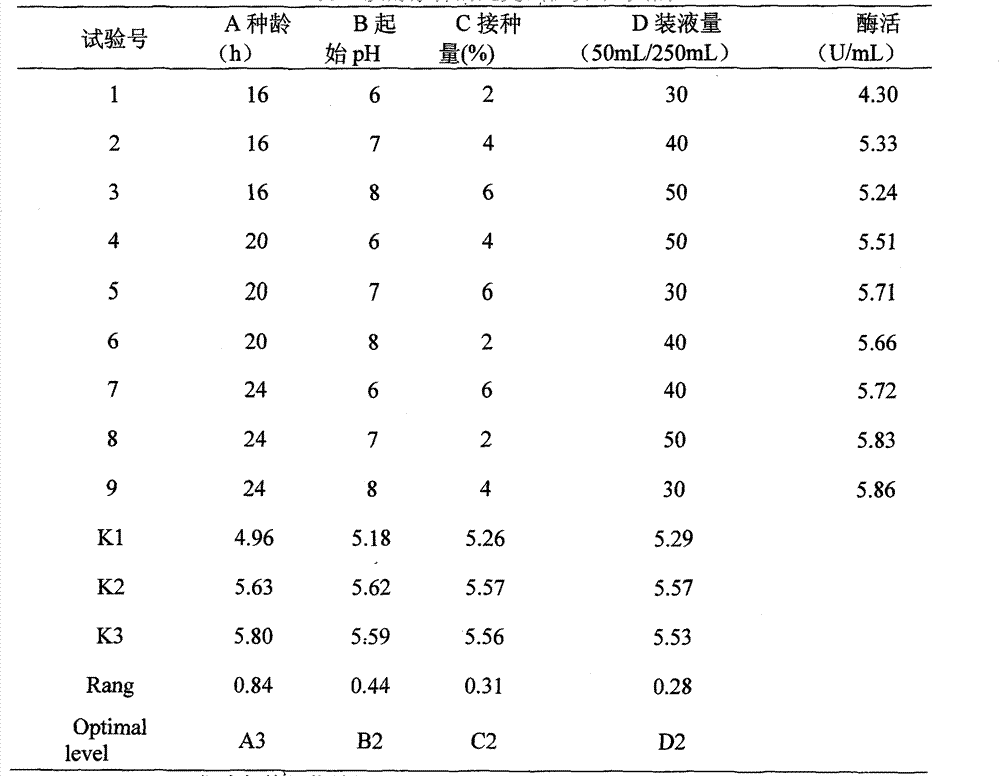Method for screening and culturing Rahnella sp.R3 producing low-temperature lactase
A Lahnella and screening method technology, applied in the direction of microorganism-based methods, biochemical equipment and methods, enzymes, etc., can solve the problem of low catalytic activity and achieve the effect of optimizing fermentation conditions
- Summary
- Abstract
- Description
- Claims
- Application Information
AI Technical Summary
Problems solved by technology
Method used
Image
Examples
Embodiment 1
[0021] Example 1: Screening method for Rahnella sp.R3 producing low-temperature lactase
[0022] (1) Primary screening: absorb the enriched culture solution and transfer it to the primary screening plate at different dilutions by the doubling dilution method, spread evenly, culture at 15°C, screen blue colonies, separate and purify, and store on the slant.
[0023] (2) Re-screening: select the upper limit temperature as 40°C, that is, strains that do not grow at this temperature are low-temperature bacteria, and select this bacteria as the test strain. The test strains preserved on the slant were activated, and the transfer fermentation culture was carried out at 15°C for shake flask culture (50mL / 250mL) for 48h. Extract the crude enzyme solution, measure the hydrolysis activity at 15°C, and select the bacteria R3 with higher activity as the test strain.
Embodiment 2
[0024] Embodiment two: Rahnella R3 (Rahnella sp.R3) strain characteristics
[0025] (1) Growth characteristics: the optimum growth temperature of the strain is 15°C; the optimum growth pH is 7
[0026] (2) Bacterial characteristics: Gram-negative, short bacilli, 1.5 μm to 2 μm in length, capsulated, without spores.
[0027] (3) Colony characteristics: The colony is yellow, round and raised, sticky in texture, smooth in edge, opaque, and easy to pick.
[0028] (4) Physiological and biochemical characteristics: fermenting D-glucose to produce acid and gas, gelatin hydrolysis test was negative, lysine and ornithine decarboxylase and arginine dihydrolase were negative, nitrate reduction, MR (methyl Red), VP (Volts-Prauter's test) were positive. Fermentable lactose, maltose, sucrose, L-rhamnose, raffinose, cellulose sugar.
PUM
| Property | Measurement | Unit |
|---|---|---|
| length | aaaaa | aaaaa |
Abstract
Description
Claims
Application Information
 Login to View More
Login to View More - R&D
- Intellectual Property
- Life Sciences
- Materials
- Tech Scout
- Unparalleled Data Quality
- Higher Quality Content
- 60% Fewer Hallucinations
Browse by: Latest US Patents, China's latest patents, Technical Efficacy Thesaurus, Application Domain, Technology Topic, Popular Technical Reports.
© 2025 PatSnap. All rights reserved.Legal|Privacy policy|Modern Slavery Act Transparency Statement|Sitemap|About US| Contact US: help@patsnap.com


